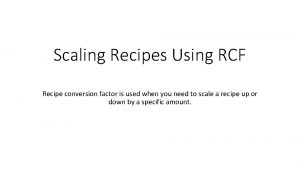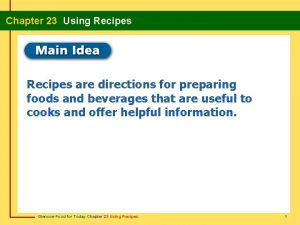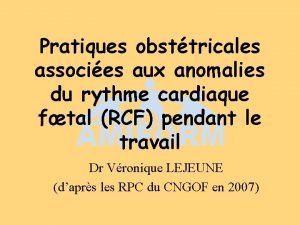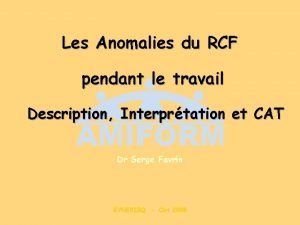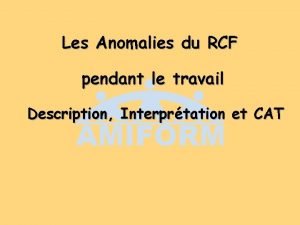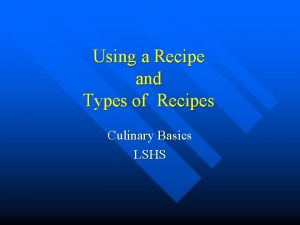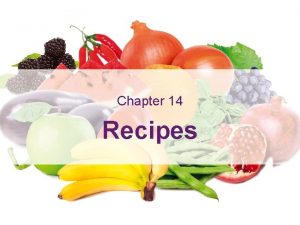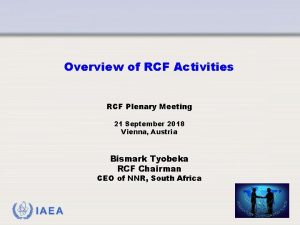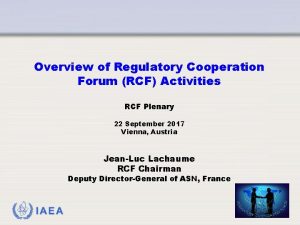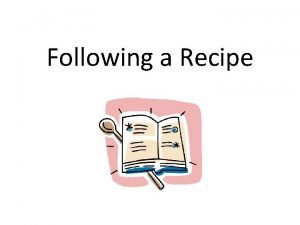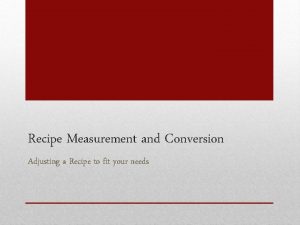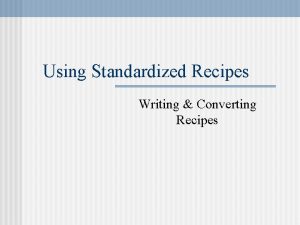Scaling Recipes Using RCF Recipe conversion factor is









- Slides: 9

Scaling Recipes Using RCF Recipe conversion factor is used when you need to scale a recipe up or down by a specific amount.

Scenario: You have a recipe that makes 10 servings of rice. You need to make 6 servings. You are scaling down. •

Example: Boiled White Rice: Ingredient Rice Salt Water Old Amount RCF New Amount 2. 5 cups x. 6 1. 5 cups 1 tsp x. 6 . 6 tsp 64 fl. oz. x. 6 38. 4 oz.

Now you try it: We need 72 blueberry muffins, our recipe makes 50. Flour 2 # 8 oz Sugar 12 oz Baking Powder 2. 5 oz Salt. 5 oz Eggs 8 oz Milk 2 # Melted butter 12 oz Blueberries 16 oz. Stumped?

Blueberry Muffins for 72. • RCF= 72÷ 50= 1. 44 • • Flour: 2# 8 oz. = 40 oz x 1. 44 = 57. 6 oz (58) Sugar 12 oz. x 1. 44 =17. 28 oz (17) Baking Powder 2. 5 oz. x 1. 44 = 3. 6 oz (3. 5) Salt. 5 oz x 1. 44 =. 72 oz (. 75) Eggs 8 oz. x 1. 44= 11. 52 oz. (11. 5) Milk 2# =32 fl oz. x 1. 44= 46. 08 oz. (46) Melted butter 12 oz. x 1. 44= 17. 28 oz (17) Blueberries 16 oz. x 1. 44= 23. 04 (24), because you can never have too many blueberries!

Putting it in real terms…. . • • Flour 58 oz ÷ 16 =3. 625#or 3# 10 oz. (1#=3⅓ cups) Sugar 17 oz 1# 1 oz (1#=2¼ cups) Baking Powder 3. 5 x 2= 7 T (1 oz. B. P. =2 T) Salt . 75 ozx 5 t= 3. 75 t 3¾t (1 oz. salt=5 t) Eggs 11. 5 ozx 1. 67 6. 8 ea. (Yikes! Round up to 7) Milk 46 oz÷ 8 (oz/cup) 5¾ cups (you could just use volume!) Melted Butter 17 oz 1# 1 oz. Blueberries 1# =3 -3. 5 cups 3. 5 cups (because blueberries are tasty) Name one advantage to using weight measurements instead of home measures (cups and tablespoons).

Some questions for reflection: • How would you scale a recipe for different portion size? • How would you scale a recipe based on how much you have on hand of a certain ingredient? • If you have a liquid measurement for eggs in ounces how do you know how many eggs you need?

Costing!! • AP= As Purchased • EP= Edible Portion • Yield: Percentage amount of fruit or vegetable you can use after preparing. That is the: Without the Which is 67%! Or . 67

• Take the AP cost $2. 99/#, divide by. 67 and you have the EP cost of 1 # of bananas or $4. 46. So, if I am making a recipe for banana bread that calls for 2# of bananas, I multiply 2# by $4. 46 to get $8. 82. Wow, that’s a lot! No wonder everyone loves my banana bread! • Can you name a fruit or vegetable which has almost the same cost AP as EP? That would mean there was little if any waste. How could this knowledge affect your work when you are cooking? Remember! Yield % only applies to ingredients where you loose something in the preparation! There is no Yield % on milk!
